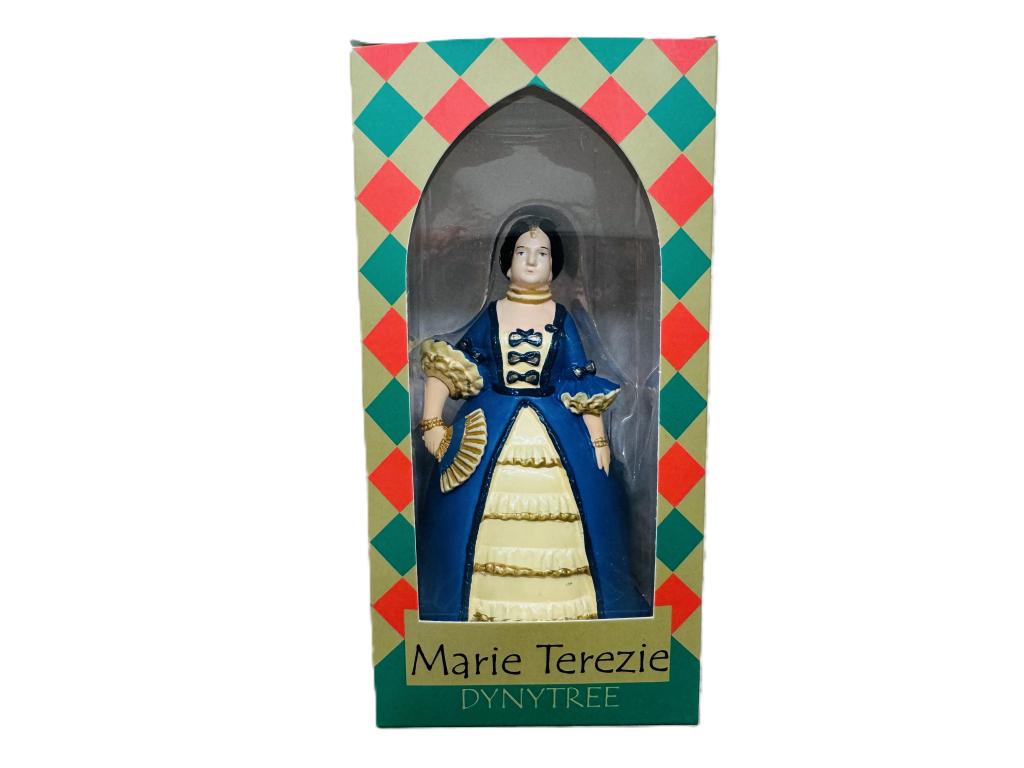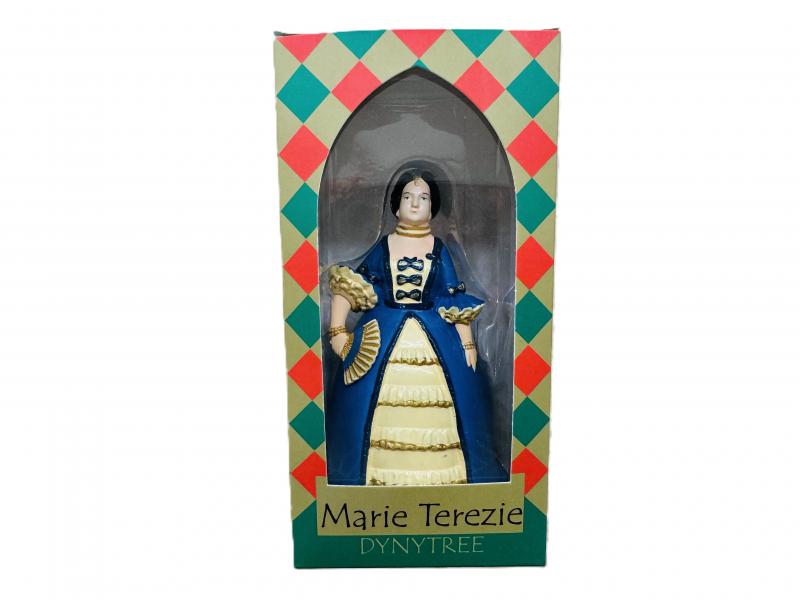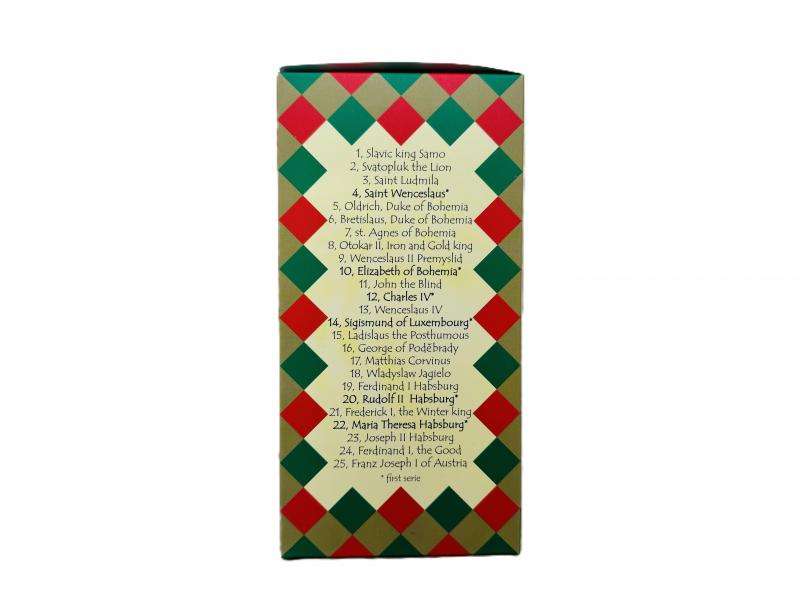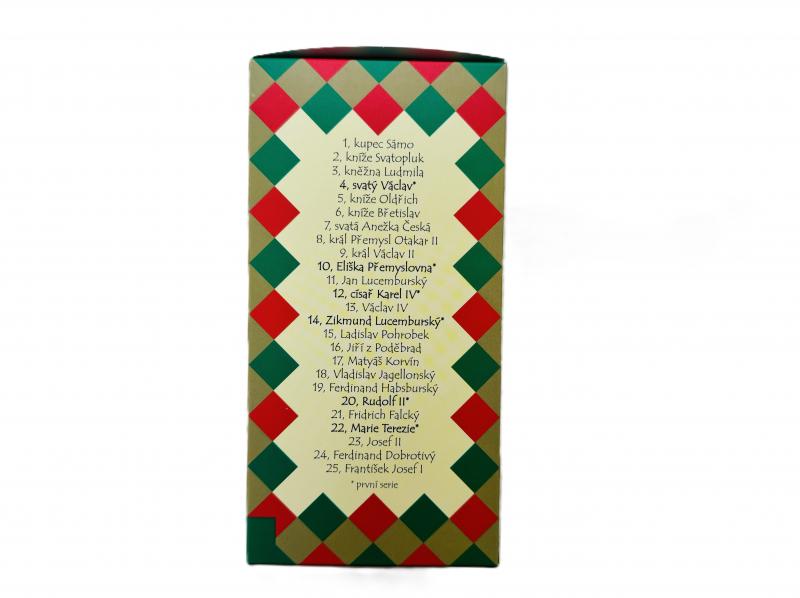K11 Statue of the Maria Theresa
Figure of Maria Theresa, one of the most important personalities of the Habsburg family - a gift and souvenir for all history lovers and visitors to Bohemia Celý popis
Overview
Figure of Maria Theresa, one of the most important personalities of the Habsburg family - a gift and souvenir for all history lovers and visitors to Bohemia
What to Expect
Description:
The figure depicts Maria Theresa in a large court toilet with a train, typical hairstyle of powdered hair. Blue is said to have been the favourite colour of the monarch.
Details:
The figurine is plastic, hand painted, 12 cm tall, housed in a mica opening case and a paper box measuring 8x8x16 cm. The figure has EC type certificate 110460 T/NB - toy. The figure comes with a leaflet with short information about all 6 figures of the 1st series in Czech, English and German.
Biography:
She was born on 13 May 1717 and received the name Maria Theresa Walburg Amalia Christina. Her father was Emperor Charles VI and her mother was Elisabeth Christine of Brunswick. The royal couple had no male descendants, their only son Prince Leopold dying as a child. The emperor was concerned about the future of the monarchy and therefore already in 1713 he announced a pragmatic sanction that guaranteed the succession rights of women in the Habsburg family.
Maria Theresa therefore grew up as the presumed heiress of the Habsburg lands. It is all the more surprising that she received only the education customary for women of royal families. These included religion, Latin, French, German, drawing, dancing and music. Maria Theresa was reportedly musically gifted, performing before audiences at an early age, singing and dancing. From today's point of view, we find it strange that no one thought to educate the future monarch in history, economics and political science. Maria Theresa had to acquire this knowledge during her reign, 'on the fly'. In her childhood she was very fond of her tutor Charlotte Fuchs, who accompanied her throughout her adult life and is buried in the Imperial Tomb alongside her beloved mistress. As a girl, MT was said to have been very charming, with fair hair, blue eyes and a slender figure. Later in life, as a result of many pregnancies, she suffered from considerable overweight and probably high blood pressure.
Of course, the key issue was the marriage of the future heiress to the monarchy. In 1723, the young Duke of Lorraine, Franz Stephan, then fifteen years old, came to the Viennese court and the young princess reportedly fell in love with him at first sight. Maria Theresa's father, Charles VI, also took a great liking to the young man, perhaps replacing his son, whom the Emperor did not live to see. However, France's opposition to the union of Lorraine and the Habsburg states was an obstacle to the wedding. Ironically, the situation was only resolved by the War of the Polish Succession between 1733 and 1735, in which Francis Stephen lost Lorraine to France, which had no reason to protest against the planned marriage. The wedding took place on 12 February 1736 in Vienna and the celebrations lasted two days. The marriage was undoubtedly a happy one and very harmonious by royal standards. Maria Theresa gave birth to 16 children in total and was very fond of her husband until his death.
On 20 October 1740, Emperor Charles VI died suddenly and Maria Theresa became heir to the throne at the age of 23. But she has yet to have most of her royal ranks confirmed. The countries that had approved of the emperor's pragmatic sanction are now reluctant, demanding all sorts of concessions and benefits for themselves in return for recognizing a woman on the throne. Maria Theresa, just after her father's death and in her fifth month of pregnancy, found that problems were occurring in virtually every part of her empire.
Prussia, led by Frederick II, was the first to attack Maria Theresa, demanding the surrender of Silesia. When MT responded in the negative, Frederick II and his army occupied Silesia and began a series of battles that would go down in history as the War of the Austrian Succession. Prussia is heavily outnumbered and the Austrian army is not in good shape. Prussia is joined by other states such as France, Spain, Bavaria and Saxony. MT is alone against many enemies. Perhaps a big boost for her was the birth of her son and Crown Prince Joseph on March 13, 1741. Until then, the Queen had only daughters. MT travelled to Hungary where she secured the military and political support of the Hungarian nobility. She becomes Queen of Hungary and is crowned on 25 June 1741 and the Hungarian lands provide her with an army of approximately 30,000 men. Meanwhile, French troops crossed the western border and captured Linz and eventually Prague. The leader of the army, Elector Karl Albrecht of Bavaria, is crowned King of Bohemia. Maria Theresa therefore hastily makes peace with Prussia to prevent the two armies from joining against her. But she must leave all of Silesia to Frederick II. Thanks to the peace treaty, the entire Austrian army can concentrate on regaining Bohemia. This was achieved by Christmas 1742. Maria Theresa is crowned Queen of Bohemia on May 12, 1743, thus becoming the first and only woman on the Bohemian throne in history. Austria defeats France and England and the French are forced to retreat across the Rhine. But the fighting and battles continue and victories alternate with defeats. It is not until 1748 that peace is made and most countries finally recognise the pragmatic sanction and position of Maria Theresa.
The political situation in Europe looks in favour of MT's husband Franz Stephan and he becomes Roman Emperor as Franz I in 1745. From then on, Maria Theresa is referred to as Empress, but as a woman she could never be elected Empress.
In 1756, MT enters into a treaty of alliance with France, and Prussia responds by invading Saxony without declaring war. This begins another seven-year Prusso-Austrian war, which later also involves Russia and Sweden. This war ended again without any significant territorial gains. Prussia retained Silesia.
Fortune, which favoured MT on the field of war only occasionally, was very much in her favour in family life. Maria Theresa had sixteen children, 11 of whom survived to adulthood. MT was a caring, if perhaps overbearing, mother and paid much attention to her children and their upbringing. She also strategically planned their marriages so that they would bring the most benefits to Austria. Perhaps the motto 'Tu felix Austria nube', or let others fight the wars, let the happy Austrians sleep. Unfortunately, what brought profit and benefit to the Austrian lands very often did not bring good to the participants in the marriage. A large proportion of the marriages arranged by the Queen of MT were not happy ones and some ended in near personal tragedy.
In 1765, Maria Theresa's husband Emperor Franz I died suddenly of a heart attack. MT bore the death of her beloved husband very hard, dressing only in black clothes and giving away all her jewels until her death. MT's son Joseph II automatically becomes the Roman Emperor after his father's death, as he had already been elected King of Rome. MT also appointed Joseph II as her co-emperor as early as September 1765. But differences of opinion and disagreements soon became apparent between mother and son. Maria Theresa still manages to conclude a final peace treaty with her long-time enemy Frederick II. In early November, Empress MT catches a cold while hunting and dies on 29 November 1780. She is buried in Vienna in the Capuchin Crypt. Maria Theresa left behind her hereditary lands in a better condition than they were after her father's death and introduced many modern establishments and administrative tools into the civil service that survived for many years after her reign. During her reign, among other things, the Universal School Code was introduced, which provided for universal education. MT was a deeply religious woman and supported monasteries and religious establishments. On the other hand, she did not shy away from the advances of science, for example, she had some members of her family vaccinated against smallpox, which was a complete novelty in medicine at that time. Seven of Maria Theresa's children sat on some of Europe's royal thrones.
Availability:
You can pick up the product anytime from 9.00 to 16.00 at our GET PRAGUE GUIDE office at Maiselova 5, 110 00, Prague 1 or we can send it to you by post to your address (postage is not included in the price of the product).
Customer service phone number +420 725 744 770
Thank you, your GetPragueGuide




